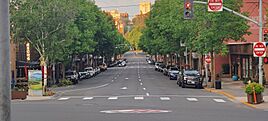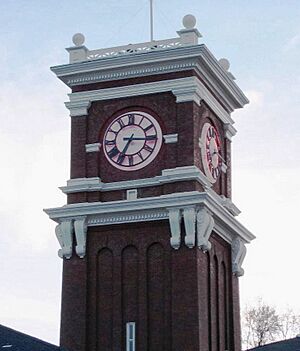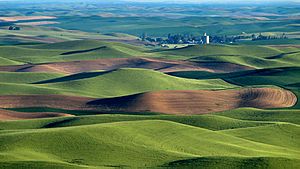Pullman, Washington facts for kids
Quick facts for kids
Pullman, Washington
|
|
|---|---|
|
Main Street
Martin Stadium
Schweitzer Engineering Laboratories headquarters
|
|
| Nickname(s):
The Lentil Capital
|
|
| Motto(s):
HIGH Tech, HIGHER Education, HIGHEST Quality of Life
|
|
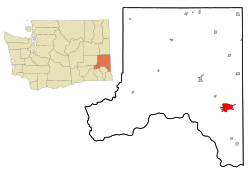
The location of Pullman in Washington
|
|
| Country | United States |
| State | Washington |
| County | Whitman |
| Incorporated | April 11, 1888 |
| Named for | Was named Three Forks, for the three creeks which form South Fork Palouse River. Renamed Pullman on July 4, 1881 for the railroad car. |
| Government | |
| • Type | Strong Mayor–Council |
| Area | |
| • Total | 11.12 sq mi (28.81 km2) |
| • Land | 11.12 sq mi (28.81 km2) |
| • Water | 0.00 sq mi (0.00 km2) |
| Elevation | 2,352 ft (717 m) |
| Population
(2020)
|
|
| • Total | 32,901 |
| • Estimate
(2022)
|
32,508 |
| • Density | 2,920/sq mi (1,128/km2) |
| Time zone | UTC–8 (Pacific (PST)) |
| • Summer (DST) | UTC–7 (PDT) |
| ZIP Codes |
99163, 99164
|
| Area code(s) | 509 |
| FIPS code | 53-56625 |
| GNIS feature ID | 1531905 |
Pullman is a city in southeastern Washington. It is the largest city in Whitman County. In 2020, about 32,901 people lived here. The city was first called Three Forks. It was renamed in 1884 after a famous industrialist named George Pullman.
Pullman is known for its rich farmland. Many miles of rolling hills produce crops like wheat and legumes (like lentils). It is home to Washington State University (WSU). WSU is a big public research university. Pullman also hosts the main office of Schweitzer Engineering Laboratories. The city is about 8 miles (13 km) from Moscow, Idaho. It shares an airport with Moscow, called the Pullman–Moscow Regional Airport.
Contents
History of Pullman
In 1876, a man named Bolin Farr arrived in the area. He set up camp where two creeks meet the Palouse River. Soon after, Dan McKenzie and William Ellsworth also came. They claimed land nearby. This area was first called Three Forks. In 1881, Orville Stewart opened a general store. Bolin Farr then planned out 10 acres (4 ha) of his land for a town.
Pullman officially became a city on April 11, 1888. It had about 250 to 300 people then. The name Three Forks came from the three small rivers that meet there. These were Missouri Flat Creek, Dry Fork, and the South Fork of the Palouse River. In 1884, the site was renamed Pullman. This was in honor of American industrialist George Pullman.
In 1890, Washington State decided to build a new college. Pullman leaders worked hard to get the college in their city. They offered 160 acres (65 ha) of land for the campus. On April 18, 1891, Pullman was chosen as the location. The college opened in 1892 with 59 students. It was first called Washington Agricultural College and School of Science. Later, it became Washington State University in 1959.
Since 1961, Pullman has been run by a mayor–council government. This means the city has an elected mayor. It also has an elected council with seven members.
Pullman's Geography
Pullman is in the eastern part of Whitman County. It is about 65 miles (105 km) south of Spokane. The city covers about 11.12 square miles (28.81 km2) of land.
The city is built on several loess hills. These hills are part of the Palouse Prairie. They were formed by windblown dirt over a million years. This area is known for its rich, rolling hills. Farmers grow crops like wheat, barley, canola, lentils, and peas here. The hills make the city have different heights. Downtown Pullman is in a valley between these hills. Two creeks, Missouri Flat Creek and Paradise Creek, join the South Fork of the Palouse River in Pullman.
Pullman is divided into four main areas by its hills:
- Military Hill: This is north of the Palouse River.
- Pioneer Hill: This is south of Main Street.
- Sunnyside Hill: This is south of Davis Way.
- College Hill: This is north of Main Street.
Military Hill got its name from the Pullman Military College. This college opened in 1891 but burned down in 1893.
Climate in Pullman
Pullman has a warm-summer Mediterranean climate. This means it has hot, dry summers. The winters are cold and wet. Spring and fall are short seasons in between. Because of the Cascade Range mountains to the west, Pullman often has clear skies. It gets much less rain than cities west of the mountains. From June to September, there are very few clouds. This causes big temperature changes between day and night in summer. Pullman gets about 20.41 inches (518 mm) of rain each year.
| Climate data for Pullman–Moscow Regional Airport, Washington (1991–2020 normals, extremes 1893–present) | |||||||||||||
|---|---|---|---|---|---|---|---|---|---|---|---|---|---|
| Month | Jan | Feb | Mar | Apr | May | Jun | Jul | Aug | Sep | Oct | Nov | Dec | Year |
| Record high °F (°C) | 59 (15) |
66 (19) |
73 (23) |
88 (31) |
94 (34) |
106 (41) |
104 (40) |
110 (43) |
100 (38) |
90 (32) |
73 (23) |
64 (18) |
110 (43) |
| Mean maximum °F (°C) | 49.8 (9.9) |
53.5 (11.9) |
63.7 (17.6) |
73.6 (23.1) |
82.7 (28.2) |
88.4 (31.3) |
96.3 (35.7) |
98.0 (36.7) |
91.3 (32.9) |
77.5 (25.3) |
60.1 (15.6) |
49.7 (9.8) |
98.8 (37.1) |
| Mean daily maximum °F (°C) | 37.6 (3.1) |
41.6 (5.3) |
49.3 (9.6) |
56.4 (13.6) |
65.4 (18.6) |
71.9 (22.2) |
83.1 (28.4) |
83.4 (28.6) |
74.2 (23.4) |
59.2 (15.1) |
44.7 (7.1) |
36.6 (2.6) |
58.6 (14.8) |
| Daily mean °F (°C) | 32.7 (0.4) |
35.4 (1.9) |
41.1 (5.1) |
46.8 (8.2) |
54.5 (12.5) |
59.8 (15.4) |
67.0 (19.4) |
66.9 (19.4) |
59.8 (15.4) |
48.4 (9.1) |
38.6 (3.7) |
31.8 (−0.1) |
48.6 (9.2) |
| Mean daily minimum °F (°C) | 27.8 (−2.3) |
29.2 (−1.6) |
32.9 (0.5) |
37.2 (2.9) |
43.7 (6.5) |
47.7 (8.7) |
50.9 (10.5) |
50.4 (10.2) |
45.4 (7.4) |
37.6 (3.1) |
32.5 (0.3) |
26.9 (−2.8) |
38.5 (3.6) |
| Mean minimum °F (°C) | 7.4 (−13.7) |
11.0 (−11.7) |
19.0 (−7.2) |
26.3 (−3.2) |
30.8 (−0.7) |
36.4 (2.4) |
40.5 (4.7) |
38.7 (3.7) |
31.3 (−0.4) |
21.5 (−5.8) |
15.0 (−9.4) |
8.1 (−13.3) |
−2.3 (−19.1) |
| Record low °F (°C) | −29 (−34) |
−24 (−31) |
−9 (−23) |
6 (−14) |
23 (−5) |
29 (−2) |
32 (0) |
32 (0) |
20 (−7) |
4 (−16) |
−14 (−26) |
−32 (−36) |
−32 (−36) |
| Average precipitation inches (mm) | 2.67 (68) |
1.94 (49) |
2.05 (52) |
1.96 (50) |
1.81 (46) |
1.22 (31) |
0.44 (11) |
0.48 (12) |
0.65 (17) |
1.80 (46) |
2.62 (67) |
2.77 (70) |
20.41 (519) |
| Average snowfall inches (cm) | 9.6 (24) |
4.8 (12) |
2.5 (6.4) |
0.7 (1.8) |
0.1 (0.25) |
0.0 (0.0) |
0.0 (0.0) |
0.0 (0.0) |
0.0 (0.0) |
0.1 (0.25) |
4.6 (12) |
10.3 (26) |
32.7 (82.7) |
| Average precipitation days (≥ 0.01 in) | 14.0 | 11.5 | 12.3 | 11.1 | 9.6 | 8.3 | 3.8 | 3.5 | 4.6 | 9.0 | 13.6 | 13.9 | 115.2 |
| Average snowy days (≥ 0.1 in) | 4.8 | 3.4 | 1.9 | 0.4 | 0.1 | 0.0 | 0.0 | 0.0 | 0.0 | 0.1 | 2.6 | 4.9 | 18.2 |
| Source 1: NOAA | |||||||||||||
| Source 2: National Weather Service | |||||||||||||
People of Pullman
| Historical population | |||
|---|---|---|---|
| Census | Pop. | %± | |
| 1890 | 868 | — | |
| 1900 | 1,308 | 50.7% | |
| 1910 | 2,602 | 98.9% | |
| 1920 | 2,440 | −6.2% | |
| 1930 | 3,322 | 36.1% | |
| 1940 | 4,417 | 33.0% | |
| 1950 | 12,022 | 172.2% | |
| 1960 | 12,957 | 7.8% | |
| 1970 | 20,509 | 58.3% | |
| 1980 | 23,579 | 15.0% | |
| 1990 | 23,478 | −0.4% | |
| 2000 | 24,675 | 5.1% | |
| 2010 | 29,799 | 20.8% | |
| 2020 | 32,901 | 10.4% | |
| 2022 (est.) | 32,508 | 9.1% | |
| U.S. Decennial Census 2020 Census |
|||
In 2011, Bloomberg Businessweek magazine said Pullman was the "Best Place to Raise Kids" in Washington. They looked at things like how affordable it is and how safe it is. They also considered the good schools and the natural beauty of the area.
2020 Census Information
In 2020, there were 32,901 people living in Pullman. There were 12,185 households. About 19.5% of households had children under 18. The average household had 2.2 people. The average family had 2.9 people.
About 13.1% of the people were under 18 years old. Many people, 45.7%, were between 18 and 24 years old. The average age in Pullman was 22.7 years.
Pullman's Economy
Washington State University (WSU) is the biggest employer in Pullman. It also employs the most people in Whitman County.
Pullman is part of the Palouse Knowledge Corridor. This area has many high-tech companies. Schweitzer Engineering Laboratories (SEL) is a large private employer here. It was started by Edmund Schweitzer, who studied at WSU. SEL and other companies are in the Pullman Industrial Park. This park is managed by the Port of Whitman County.
Pullman Regional Hospital opened in 2004. It replaced an older hospital on the WSU campus.
Agriculture in Pullman
- Dumas Seed Company warehouse
Culture and Fun in Pullman
Since 1989, Pullman has hosted the National Lentil Festival. This is a big event that celebrates the lentils grown in the Palouse region. The festival has a lentil cook-off and a street fair. There's also a parade and music in the park. It happens in Reaney Park in August, before WSU classes start.
Sports in Pullman
Washington State Cougars college sports are very popular in Pullman. The Cougars play in the Pac-12 Conference in NCAA Division I. The football team plays at Martin Stadium. Their big rival is the Washington Huskies. They play each other in a game called the Apple Cup.
The women's and men's basketball teams play at Beasley Coliseum. The baseball team plays at Bailey–Brayton Field. Track and field events are held at Moobery Track. Bohler Gymnasium is where the women's volleyball team plays. The city also has an 18-hole golf course called Palouse Ridge Golf Club.
The Greyhounds are the sports teams for Pullman High School. They compete in WIAA Class 2A. Their rivals include the Clarkston Bantams and the Moscow Bears.
Theatre in Pullman
- Regional Theatre of the Palouse
- Pullman Civic Theatre
Music in Pullman
Pullman has several music groups and concert series. The Washington Idaho Symphony performs about six concerts each season. The Palouse Choral Society has about five concerts a year. The Washington State University School of Music puts on over 100 concerts. These concerts feature guest artists, teachers, and students. Some big events include the Festival of Contemporary Artists in Music and the Holiday Celebration. There is also an outdoor summer music series called Fridays at the Clock.
Education in Pullman
The Pullman School District includes these schools:
- Franklin Elementary School
- Jefferson Elementary School
- Sunnyside Elementary School
- Kamiak Elementary School
- Lincoln Middle School
- Pullman High School
Pullman High School (PHS) is the city's only public high school. It has about 700 students. Its sports teams are called the Greyhounds. PHS offers advanced classes and college-level courses. Students can take these through Washington State University (WSU) and Spokane Falls Community College.
Washington State University
Washington State University (WSU) is a major university in Pullman. It is a member of the Pac-12 Conference. WSU is the second-largest university in Washington state. It is well known for its programs in veterinary medicine, business, architecture, engineering, agriculture, pharmacy, and communications.
Transportation in Pullman
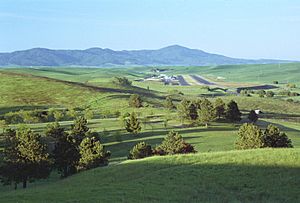
Pullman is located near where U.S. Route 195 and Washington State Route 27 meet. These roads go north towards Spokane. US 195 also goes south towards Lewiston, Idaho. Washington State Route 270 connects Pullman to Moscow, Idaho. This road also follows the Bill Chipman Palouse Trail.
The city has its own bus service called Pullman Transit. It provides bus rides for residents and WSU students. WSU students can ride for free with their student ID. The bus service also offers extra shuttles for big events at WSU. Pullman also has buses that go to Spokane.
Pullman is served by the Pullman–Moscow Regional Airport. This airport is about 2 miles (3 km) east of Pullman. Alaska Airlines has daily flights from this airport to Seattle–Tacoma. They also have flights to Boise during the school year. The closest major airport is Spokane International Airport.
Notable People from Pullman
- Pat Beach, a professional football player (NFL tight end).
- John Elway, a Hall of Fame NFL quarterback, lived in Pullman and went to Pullman High School for a year.
- John M. Fabian, a former NASA astronaut, graduated from Pullman High School and WSU.
- Susan Fagan, a politician in the Washington House of Representatives.
- Jean Hegland, a novelist, was born and grew up in Pullman.
- William La Follette, a U.S. Congressman, lived in Pullman.
- Gary Larson, a famous cartoonist, graduated from Washington State University.
- Young Jean Lee, a playwright, grew up in Pullman.
- James Mattis, a former US Marine Corps general and Secretary of Defense.
- Ron C. Mittelhammer, a former director at WSU and president of an economics association.
- Timm Rosenbach, an NFL quarterback, played at Pullman High School and WSU.
- Edmund O. Schweitzer III, who started Schweitzer Engineering Laboratories.
- Kirk Triplett, a professional golfer, graduated from Pullman High School in 1980.
See also
 In Spanish: Pullman (Washington) para niños
In Spanish: Pullman (Washington) para niños


